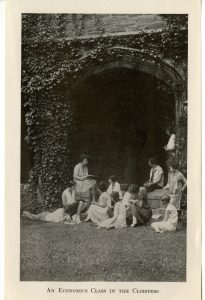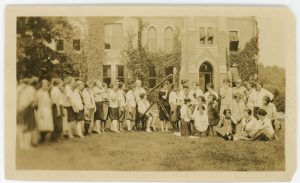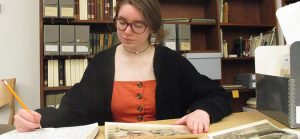by Beck Morawski ’21
When I was brought on as a student curator to design an exhibit for the centennial of the Bryn Mawr Summer School for Women Workers in Industry last April, I could not have imagined the journey this project would take me on. In putting together a digital exhibit that centers the lived experiences of often-overlooked students, I was able to engage with the history of Bryn Mawr College in ways I never expected.
The Bryn Mawr Summer School for Women Workers in Industry, often abbreviated as the BMSSWWI, was a program that ran on Bryn Mawr’s campus during the summer from 1921 through 1938. It was intended to use the empty campus buildings during the summer months to educate industrial workers—such as factory workers or manual laborers—who sought to continue their education, since often their life circumstances had prevented them from finishing it. The unique program allowed for a two month retreat to the secluded campus to study not only Economic Theory, but also topics meant to enrich life outside of the workplace including Literature, Astronomy, and Music Theory.

Image courtesy Bryn Mawr Special Collections. An Economics Class in the Cloisters. BMC-Photo Archives, Series I, PAE: Events and Groups, SSWWI. SSWWI_00195. https://digitalcollections.tricolib.brynmawr.edu/object/bmc60985.
While classroom lessons and lectures were instrumental to the students in attendance, some of the most formative experiences they recounted in the Summer School literary magazine Shop and School were of exploring the campus and experiencing life away from the smog and cramped confines of cities and mills. It was exciting to get to read these students’ stories and experiences attending college for the first time, and then to find a way to share them with the Bryn Mawr community today. By putting our current campus culture and experiences in conversation with our history, we can gain new understandings of how unique Bryn Mawr can be.
Developing a digital exhibit of photographs and documents was an interesting challenge to take on while working remotely. Working in Special Collections during my time at Bryn Mawr, I learned the importance and value of physical records to the day-to-day ongoings of campus and how they enliven history to those that study it. However, what does that look like when one can’t work hands-on with the many photographs, letters, and books that we have saved from the Summer School? Luckily, the influence of the School was wide-reaching and impactful. Even without going into Canaday Library I could find material that explored the history of the School from unexpected angles. I was also able to participate in conversations around the digitization of parts of our collections, hoping to make our holdings more accessible to those who otherwise wouldn’t be able to access the materials we hold.
My exhibit—For Roses, Too—provides an overview of the Summer School program and its history, while asking readers what lessons they can take from its history to apply to Bryn Mawr College today. The BMSSWWI exemplifies both what progress Bryn Mawr has historically sought to accomplish and what that vision can achieve when embraced by the community. It is my hope that this exhibit can start new and exciting conversations about our institutional identity and its place in history at large.

Image courtesy Bryn Mawr Special Collections. Students from the Bryn Mawr Summer School for Women Workers in Industry. BMC-Photo Archives, Series I, PAE: Events and Groups, SSWWI, SSWWI_00016. https://digitalcollections.tricolib.brynmawr.edu/object/bmc60806.


Thank you!
What a wonderful job you have done capturing the experiences of the students in the Summer School! My mother-in-law attended the School one summer. Unfortunately I did not spend much time trying to understand her experience. I am trying to figure out what year she attended. Since she was born in 1914 and must have been at least 18, it would have been 1933 or later. Her name was Rose Travis and she lived in Fall River, MA. Eventually she became the office manager at the Fall River ILGWU. She was fearless as a union organizer. Is there a way I can find out what year she attended?
Thank you for contributing this research and the digital exhibit, “For roses, too.” It’s wonderfully done. // @Cindy, if you are still looking into the question, I wonder if the student rosters in the College’s archives would have an answer for you:
[http://archives.tricolib.brynmawr.edu/repositories/6/archival_objects/96462].
As organizers, these summer school alumnae/i raised standards and improved workers’ lives. There’s this mention from the ILGWU’s magazine in 1946, (“NE workers win boost”, p.11). Hopefully you have had the chance to see this. In solidarity. [https://ecommons.cornell.edu/bitstream/handle/1813/83803/Justice_28_9.pdf?sequence=1&isAllowed=y